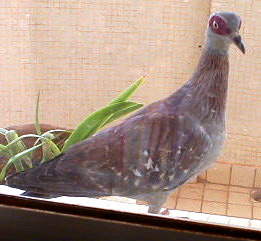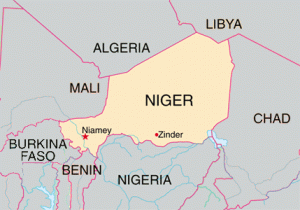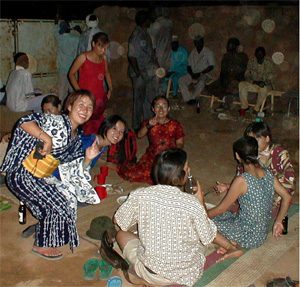by J. R. Bullington
The latest in a continuing series by Amb. Jim Bullington, Peace Corps director in Niger. For other of his fascinating reports from that West African nation, click here. —Ed.
| The Sahel Dove (With apologies to Edgar Allen Poe)On a Niger noontide fiery, As I pondered some inquiry From a proud Potomac bureaucrat,Suddenly there came a pounding Sound of beak on glass resounding At my office window where there satA bird, perhaps a messenger of Peace. Sahel dove, are you not wary? Or has the heat become so burning |
|||
 |
|||
Waiting for the Rain
Everyone in Niger is waiting for the rain, which normally begins in early June. For most people its timely arrival in adequate quantity means the difference between enough to eat and gnawing hunger. For expatriates like us, it means a break from the blazing heat of April and May, into which we occasionally have to venture from the sanctuaries of our air-conditioned offices, homes and cars.
 Somehow, though, even the heat becomes tolerable. All through the hot season, Tuy-Cam and I have continued to enjoy breakfast on our newly screened verandah. One morning last week there was a nice breeze, and we both remarked on the pleasant weather. On checking the thermometer, we found that it registered 91.
Somehow, though, even the heat becomes tolerable. All through the hot season, Tuy-Cam and I have continued to enjoy breakfast on our newly screened verandah. One morning last week there was a nice breeze, and we both remarked on the pleasant weather. On checking the thermometer, we found that it registered 91.
Perhaps we are becoming like the Nigeriens, who don sweaters and coats whenever it falls below 80.
An Endangered River
The Niger River is also waiting for the rain, of which it is in increasingly desperate need. Its flow past Niamey has become a trickle, and people can walk across it without getting wet above the waist.
This is yet another looming tragedy for Niger and the other countries along the 2600-mile course of one of Africa’s great rivers. According to a recent study done for the Ministry of Water Resources and the Struggle against Desertification (yes, there is such a ministry here, one of the most important in the Government), if the Niger’s flow continues to decrease at the rate of the past 30 years, in another 30 years it will no longer be a river, at least during most of the year, but only a chain of lakes and swamps.
For millions of desperately poor people who are economically dependent on the Niger, the implications of this are difficult to contemplate.

The Niger’s problems, like those of this continent generally, are multiple and difficult if not impossible to solve. First, there is climate change, which has caused the Sahara to advance over 100 km southward in the past half century. The effects of this change are greatly exacerbated, moreover, by man-made assaults on the environment, mostly related to unbridled population growth. More people have meant more irrigation, which lowers the water table, as well as widespread deforestation, which causes erosion and reduces the land’s ability to hold water. A dozen dams along the Niger have also slowed its flow and increased evaporation. And finally, an infestation of water hyacinth is choking the river along much of its course.One effect of the river’s recent low water level is that it becomes easier to spot and net some of the huge capitaine that inhabit it. These fish, known as Nile perch in English, are among the most delicious I’ve had anywhere. Last month, Tuy-Cam bought one in the market that weighed 86 pounds. We are still enjoying it.
Efforts are under way to reverse some of the damage to the river, with erosion control projects, reforestation and the like, but at best they have thus far only slowed it.
Romance and Reality
Recently I visited the Volunteers in the region of Gaya, a small town on the Niger River where it forms the border between Niger and Benin. It’s on field trips such as this that I feel most intensely both the exhilarating romance and the harsh realities of life in Niger.
After a four-hour drive from Niamey and visits to three Volunteers in their villages, I checked into Gaya’s best hotel. By small-town Africa standards, it’s an excellent hotel, with air-conditioned rooms and a pleasant bar and restaurant. By American standards, it would be judged an unacceptable dump to be closed down by the health department.

As I sat on the verandah of the bar, enjoying a cold Biere Niger, I reflected on the romance, the adventure, of being at a hotel in a small, remote Niger River town in the heart of Africa, and how much I enjoyed being right there, right then. I observed my fellow bar patrons – three convivial, pot-bellied policemen, a voluble traveling salesman from Nigeria, a rich local merchant, a Government bureaucrat from Niamey, and a pair of pretty ladies in tight-fitting Western clothes who appeared to be very accustomed to being in this setting – and I reflected that I was probably the only white person within 50 miles except for the six Volunteers who live in area villages. After an hour of such musing, I was joined for dinner by two of the Volunteers, who were temporarily staying at our small Peace Corps hostel in Gaya. We took a table on the roof of the restaurant and watched the last rays of sunshine descend over the little town as we enjoyed more cold beer and some excellent brochettes. The total bill for all three of us was about $8.
“What a great evening,” I thought as I headed for my room, a shower and bed. “There’s really nowhere else I would rather be than here, and nothing else I would rather be doing than leading these great young Volunteers.” I wondered if other Americans would equally enjoy this experience, or if I had become increasingly eccentric in my tastes.
That’s when Africa’s romance began to be overwhelmed by some of its realities.
There was indeed a showerhead in the bathroom, but apparently no water had flowed through it in some time. The tiny sink, and the washcloth and soap I had brought from home, would have to do. The bed, which had looked so comfortable when I checked in, turned out to have a mattress that couldn’t have been more than an inch thick except for the places where it had developed three-inch lumps. I watched a lizard chase a strange looking insect across the ceiling. At least the air conditioner worked, and I had brought along my own pillow, so eventually I fell asleep.
About 2 a.m., however, the electricity went off, as of course did the air conditioner. Within minutes, the room became oppressively hot. The rest of the night was most unpleasant, and I have rarely been so grateful to see the dawn.
All in all, though, the good times outweigh the bad, and the romance still trumps the reality.
Peace Corps Legislation
New fundamental Peace Corps legislation, called the “Peace Corps Charter for the 21st Century Act,” has been drafted and is beginning to make its way through the legislative process. Its authors are Connecticut Senator Chris Dodd and California Congressman Sam Farr, who both served as Peace Corps Volunteers in the 1960s.
Most importantly, the proposed Act endorses and funds President Bush’s initiative to double the number of Volunteers (to 15,000) by 2007, making this a formal Congressional goal as well. It also rewords Peace Corps’ three basic goals, which have been unchanged since President Kennedy created the organization, and adds a fourth:
- The first goal becomes to “help people in developing nations meet basic needs” (instead of “help the peoples of interested countries meet their needs for trained manpower”).
- The second goal becomes to “promote understanding of American values and ideals abroad” (instead of “promote better understanding of the American people on the part of people served”).
- The third goal (promoting Americans’ understanding of other people) remains unchanged.
- The proposed new fourth goal is to “help promote global acceptance of the principles of international peace and non-violent co-existence among peoples of diverse cultures and systems of government.”
There are several other provisions, including a new grant mechanism providing up to $10 million per year for returned Volunteers to undertake third and fourth goal projects in the US (such as, for example, developing international content for school curricula and orientation programs for foreign students).
While there could be major changes, the legislation appears to have broad bipartisan support, and chances for passage look good.
Japanese Volunteers
Among Peace Corps’ achievements is the inspiration of similar programs in other countries, including the UK, France, Germany and The Netherlands. Probably the largest of these organizations, and the one that’s closest to the Peace Corps model, is the Japan International Cooperation Volunteers.

One of my early objectives was to explore ways in which Peace Corps might cooperate more closely with these international volunteer organizations, and the Japanese were by far the most responsive to my overtures. They currently have 53 volunteers in Niger, and like ours their volunteers are almost all in their 20s and about two-thirds female. Also like ours, they live very modestly, and for the most part work directly with people in rural areas. They have recently begun to use our training facility (on a reimbursable basis when we are not using it, and it would otherwise be idle). In spite of language barriers, the Japanese and Peace Corps Volunteers sometimes form friendships, and they occasionally work together on projects.An example of this collaboration is the annual “Guinea Worm Week,” a campaign to educate villagers on how to avoid getting and transmitting this terrible affliction. The Japanese and American Volunteers, along with Nigerien health agents, spend a week going from village to village where the problem persists, and they reach several thousand people with this basic health message. Sponsored by Global 2000, an affiliate of the (Jimmy) Carter Center in Atlanta, this program has been conducted for several years in African countries where Guinea worm is endemic, and it is now coming close to its objective: The total elimination of this nasty parasite (just as smallpox was eradicated several years ago).
I recently traveled to Tera, one of the few remaining pockets of Guinea worm prevalence, to participate in the closing ceremony and celebratory dinner for this year’s “Worm Week.” It was gratifying to see this example of international cooperation in a successful assistance program, and more than a little startling to see young Americans and Japanese talking to each other in Zarma.
Super Crocs and Zinder Crocs
As long as a school bus and weighing one-and-one-half times as much as an elephant, it swam the rivers of what is now the Sahara over 100 million years ago, and preyed on unwary dinosaurs that came into the water or onto the bank. It was the world’s largest crocodile, Sarcosuchus. University of Chicago paleontologist Paul Serano unearthed its bones in a remote desert area near Agadez called Gadoufaoua, a Tuareg word indicating “the place where camels fear to tread.”
The story of Serano’s discovery was featured in a recent National Geographic, and was also the subject of a National Geographic TV special. Serano and his team come to Niger every year during the cool season, and in addition to Sarcosuchus they have discovered several new species of dinosaurs.
Some of Sarcosuchus’ modern-day, normally sized counterparts recently caused panic when they were spotted walking along the streets of Zinder, a small city in eastern Niger where we have a Peace Corps regional office to support some 20 Volunteers in the area. How the crocodiles came to be there is an interesting story, since Zinder is far from the Niger River or any other current crocodile habitat.
According to the local newspaper account, early in the 20th Century, during the French colonial period, children used to play in a lake near Zinder. Not many people in this semi-arid region with few bodies of water learn to swim, and because this particular lake was rather deep and treacherous, several of the children were drowned every year.
The colonial authorities’ solution to this problem, while certainly innovative, seems rather drastic and perhaps betrays something about the attitude of colonial masters to subject people during that era. They captured a pair of young crocodiles from the Niger River and put them into the Zinder lake. The crocodiles thrived, reproduced, and served as a highly effective deterrent to children who might think about going there for a dip. There are now about a dozen crocodiles that live in the lake.
Like other bodies of water in the Sahel region, this lake has been decreasing in size as the water table drops and desertification progresses. During the dry season, it can now get so small as to force some of the crocodiles to leave in search of new habitat – which explains their recent presence on the streets of Zinder.
At first I thought this was a tall tale, but the people of Zinder swear it’s true. Our Volunteers haven’t actually seen the crocodiles, but they know people who have.
Niger – what an interesting place to live!
Vacation
We will be in California, Georgia, Virginia, Alabama, Florida and DC for vacation and a Peace Corps Country Directors Conference June 15 – July 31. As much as we enjoy Niger, it will be great to get back to the US for a visit.![]()
